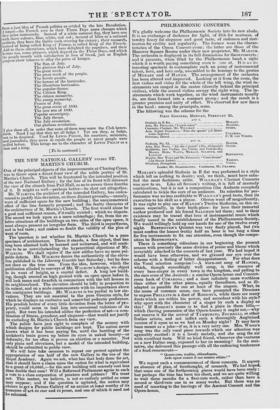THE NEW NATIONAL GALLERY versus ST. MARTIN'S CHURCH.
ONE of the principal objects of the improvements at Charing Cross, was to throw open a direct front view of the noble portico of St. Martin's Church. This will be frustrated by the intended position of the new National Gallery ; for the line of its front will intersect the view of the church from Pall Mall, so as to screen three fourths of it. It might as well—perhaps better—be shut out altogether. Mr. WiexiNs, the architect of the intended Gallery, has endea- voured to justify this deviation, on three distinct grounds,—namely, want of sufficient space for the new building ; the unsymmetrical effect of the line formerly proposed; 'and the faulty character of the architecture of St. Martin's Church. The first would alone be a good and sufficient reason, if it really existed ; which we dispute. The second we look upon as a mere subterfuge; for, from the re- lative situations of the buildings on two sides of the open space, it must always present an irregular form. The third is superfluous, and in bad taste ; and makes us doubt the validity of the plea of want of room.
The -question is not whether St. Martin's Church be a pure specimen of architecture. There it stands, a fine object, that has long been admired both by learned and unlearned, and will conti- nue to be so notwithstanding the hypercritical objections of Mr. WiLxibis. We shall rejoice if the new edifice have no more pal- pable defects. Mr. WILKINS denies the authenticity of the eleva- tion published in the Literary Gazette last Saturday; bathe does not show us the true one. From the idea, however, which the publication alluded to conveys of Mr. WiLitirts's design, we object to its want of height, as a capital defect. A long low build- ing, though erected on high ground with an open space before it, will look mean and dwarfish in comparison with the tall houses in its neighbourhood. The elevation should be lofty in proportion to its extent, and on a scale commensurate with its importance above the contiguous buildings. Mr. WILKINS is too partial to low ele- vations. They are not essential to the pure Grecian style, for which be .displays an exclusive and somewhat pedantic preference. His prudish horror of every little deviation from the letter of pro- plety, would seem to lead him into occasional violations of its spirit: But were his intended edifice the perfection of art—a com- bination of fitness, grandeur, and elegance—that would not justify its excluding St. Martin's Church from our view. The public have just right to complain of the secresy with which designs for public buildings are kept. The nation never knows what it has been paying for, until the bantling of the architect's brain grows up before its eyes in naked beauty—or , • deformity, for too often it proves an abortion or a monster. Not only plans and elevations, but a model of the intended building, should be submitted to public view. We will here take occasion to repeat our protest against the :appropriation of one half of the new Gallery to the use of the Royal Academy. Again we ask, what has that body done for art, • that it should have a claim upon the nation for what is equivalent to a gmnt of 50,000/.,—for the new building will scarcely cost less than double that sum? Will a Reformed Parliament agree to such a vote to a close corporation of painters and jobbers? We trust not. This matter, we believe, is not so entirely settled as some may suppose; and if the question is agitated, the nation may y chance to get a Picture Gallery of an extent at least worthy of its treasures of art in me and in posse, and one of .which it need not e ashamed.


















 Previous page
Previous page